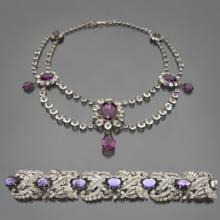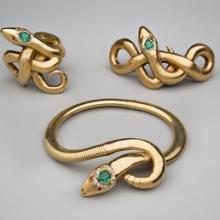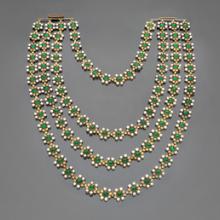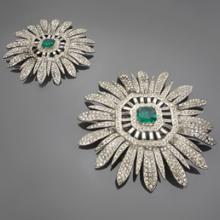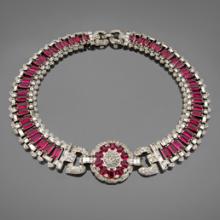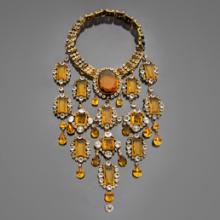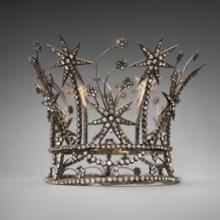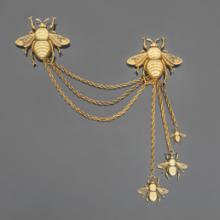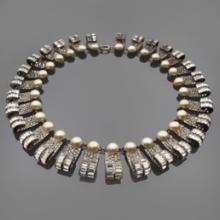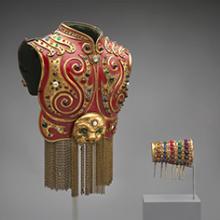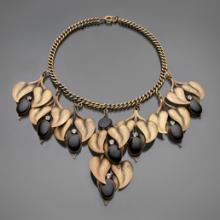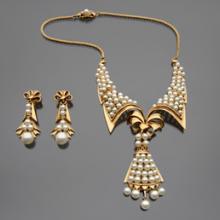International Terminal












Necklace and bracelet
Worn by Vivien Leigh in Gone With the Wind (1939)
Joseff of Hollywood
metal, glass
N1501, BC0003
L2014.3401.005, .006
R2014.3401.176.01-.02
Gone with the Wind
Clearly one of Joseff of Hollywood’s most important assignments, Gone with the Wind (1939), remains one of the most popular and commercially successful films ever made. Eugene Joseff worked with his friend and colleague Walter Plunkett, who designed the costumes for the film. Atlanta native Margaret Mitchell (1900–49) penned her novel of the Antebellum South, Civil War, and Reconstruction, while bedridden after an accident in 1926. Before the book was even published, producer David Selznick secured the film rights for fifty thousand dollars. The picture later won ten Academy Awards and grossed nearly one hundred and ninety-two million dollars.
The film’s two leading characters remain immortalized in the imaginations of fans—Rhett Butler (Clark Gable) and Scarlett O’Hara (Vivien Leigh). Although Clark Gable (1901–60) was the popular choice for leading man, he was hesitant to star in a historical drama. Gable felt that he would never be able to satisfy all the novel’s fans in his portrayal of Rhett. More than thirty actresses were screen-tested for the role of Scarlett, from Bette Davis to Lana Turner. But producer Selznick eventually chose English stage actress Vivien Leigh (1913–67) as the movie’s female lead despite public protest in favor of an American actress. An unknown in Hollywood then, today, it seems difficult to imagine anyone else in the role of Scarlett.
Snake necklace, bracelet, and tiara
Worn by Rita Hayworth in Down to Earth (1947)
Joseff of Hollywood
metal, glass
BC0881/T0119, N1402
L2014.3401.015.01-.02, .016
R2014.3401.185
Rita Hayworth
Rita Hayworth (1918–87) set the screen ablaze in films such as Blood and Sand (1941) and Gilda (1946). Born Margarita Carmen Cansino in Brooklyn, New York, Rita learned to dance at an early age from her parents. Her father was a Spanish dancer, and her mother performed as a vaudeville dancer in the Ziegfeld Follies. Her family moved to Hollywood when Hayworth was eight, and by the time she was a teenager she was performing alongside her father as his dance partner. Hayworth began to appear as a dancer in films at the age of sixteen, and by nineteen she signed with Columbia Pictures. Intent to transform her into a Hollywood starlet, Columbia suggested that Margarita change her name, raise her hairline, and lighten her raven black hair. Hayworth appeared as Fred Astaire’s dance partner in the 1941 film You’ll Never Get Rich. Soon, Time magazine elevated her star status when they featured Hayworth on its cover around the time of the movie’s release. Astaire later declared Hayworth his favorite dance partner.
In the 1947 romantic comedy Down to Earth, Hayworth wore some of Joseff of Hollywood’s exotic snake jewelry on her neck, wrists, and head. Six years later, she appeared adorned in Joseff of Hollywood creations in the flamboyant, Technicolor Salome (1953).
Necklace
Worn by Hedy Lamarr in Lady of the Tropics (1939)
Joseff of Hollywood
metal, glass, faux pearls
N0098S/BC0883
L2014.3401.081.01-.02
R2014.3441.214
Hedy Lamarr
Viennese-born Hedy Lamarr (1914–2000), billed as “the world’s most beautiful woman,” first became known for her controversial, taboo-breaking role in the Austrian film Ecstasy (1933), in which the young actress appeared nude, practically unheard of at the time. Lamarr left Europe for the United States several years later and made her American film debut in Algiers in 1938. With her alluring dark hair and ability to exude exoticism, Lamarr was continually typecast as the mysterious, desirable woman in many of her roles. After the success of Algiers, Lamarr starred in her first film under contract with MGM in Lady of the Tropics (1939).
Brooches
Worn by Alice Faye in Lillian Russell (1940)
Joseff of Hollywood
metal, glass
BR0649/BR0650
L2014.3401.092.01-.02
Alice Faye (1915–98), under contract with 20th Century Fox for a little over ten years, was one of the highest paid actresses in the late 1940s. She was known for her sultry singing voice. After she realized that the studios would be promoting her costar Linda Darnell as the new “it” girl in her last film Fallen Girl (1945), even going as far as chopping some of Faye’s scenes, she abandoned the picture before filming was complete. Faye simply left a note, turned in her dressing room keys, and drove off the set.
Art Deco-inspired necklace
Worn by Olympe Bradna in Say it in French (1938)
Joseff of Hollywood
metal glass
N0288S
L2014.3401.082
R2014.3441.142
The 1930s was an exciting time for Hollywood. Talking pictures replaced silent films. By the mid-1930s, Hollywood entered a period of unparalleled success. Many of the glamorous movie stars of the 1930s remain legendary icons today. Olympe Bradna, a French-born dancer and actress costarred beside leading men such as Gary Cooper and Ronald Regan before her early retirement from acting in 1941. She first appeared as a child star in Paris’s touring Folies Bergère.
Over-sized necklace
Worn by Ona Munson in The Shanghai Gesture (1941)
Joseff of Hollywood
metal, glass
N1371
L2014.3401.017
R2014.3401.189
This necklace was later worn by Alice Faye in That Night in Rio (1941), Tallulah Bankhead in A Royal Scandal (1945), and Linda Darnell in Forever Amber (1947).
Shanghai Gesture
Now considered a cult favorite, The Shanghai Gesture (1941) was director Josef von Sternberg’s last major film of his career. The eccentric director, famous for his films starring Marlene Dietrich, adapted the controversial 1926 play by John Colton for the silver screen. The film was made after Hollywood began censoring the content of its films. Colton’s play was high on the list of scripts too risqué for the movies. The edited script was submitted by various parties and rejected by censors thirty times over the years. In the tamer film version, Poppy, played by the beautiful Gene Tierney (1920–91), wore a number of gorgeous gowns in the film, which were selected by her fashion designer husband Oleg Cassini. Ona Munson (1903–55), best known for her role as Belle Watling in Gone with the Wind, played the wicked role of Mother Gin Sling.
Crown c. 1940s–50s
Joseff of Hollywood
metal, glass
C0027
L2014.3401.027
Actor Ronald Reagan places a crown on actress Ann Blyth 1950
After the untimely death of her husband, Joan Castle Joseff, who had stopped working with her husband after the birth of their child, courageously took charge of the foundry during a time when few women ran companies. Under the single-mother’s management, her skilled staff continued with the design and manufacture of jewelry and airplane parts, which they began making during World War II. In 1955, the executive Business Men’s club of New York named her “the world’s most glamorous business executive.”
Necklace
Worn by Ava Gardner in One Touch of Venus (1948)
Joseff of Hollywood
metal, glass, faux pearls
N0271S
L2014.3401.100
R2014.3441.170
Ava Gardner
North Carolina-native Ava Gardner was studying to be a secretary when she was discovered through a photograph that was taken of her by her brother-in-law in New York City. In 1941, at the age of eighteen, she signed a seven-year contract with MGM for a salary of fifty dollars per week. The actress was given speech lessons to vanquish her Southern drawl and began appearing in a number of films before gaining fame for her role in the 1946 film, The Killers, based on Ernest Hemingway’s novel. The bewitching Gardner was also famous for her wild life off camera and for her consecutive marriages to Mickey Rooney, Artie Shaw, and pronounced love of her life, Frank Sinatra.
Bee brooch c. 1940s
Joseff of Hollywood
metal
5874
L2014.3401.069
Retail Jewelry
Eugene Joseff realized that he could use his commercial success in Hollywood to launch a retail line of jewelry for women across the country, using the trademark, “Joseff, Jeweler to the Stars.” He had already designed costume jewelry for many stars, such as Carole Lombard and Joan Crawford to wear off-screen. Joseff not only designed beautiful, imaginative pieces for retail, he also developed inventive displays to showcase his jewelry in high-end department stores. He wrote specialty columns about jewelry in countless magazine and newspapers, which helped to further publicize his retail line. Joseff obtained a pilot license and flew his private plane to various cities on promotional tours for his retail line, where he charmed customers and retail personnel.
Breastplate
Worn by one of the three thieves in The Jungle Book (1942)
Joseff of Hollywood
metal, glass, faux pearls
JB1
L2014.3401.021
R2014.3401.190
The Jungle Book
The Jungle Book recounts the story of a boy raised by wolves in the jungle who is later adopted into human society by an Indian village. When the innocent boy later uncovers treasure in the jungle, he unleashes a host of malevolence and greed. Based on the novel The Jungle Book by Rudyard Kipling, the dazzling 1942 Technicolor film version debuted long before the 1967 Disney animated film. The Hungarian Korda brothers, who had successful careers in the British film industry, made The Jungle Book in a Hollywood studio as a result of the war in Europe. The young star of the film, Sabu Dastagir, was discovered in India at the age of thirteen by a documentary filmmaker.
The film was shot in forty-acres of man-made jungle. The studio imported a variety of plants for the set, three hundred animals were acquired from local zoos and farms, and chimpanzees were brought from India. The three thieves in the film wear a variety of Joseff of Hollywood creations, including this breastplate, which is embellished with a mythical gold head and fringe chains.
Leaf necklace c. 1940s
Joseff of Hollywood
metal, glass
2992S
L2014.3401.038
Joseff’s Jewelry Tips
Eugene Joseff cleverly advised women in their selection of jewelry in various periodicals.
* If you want to acquire a collection, start with a brooch because you will find the most use for it. It can be pinned on a suit lapel, collar or pocket…on a hat, a belt, or an evening gown. Remember, gold can be worn with more things than silver and topaz is a good stone that looks smart with almost every type of costume.
* Earrings should be the next jewelry investment. They also have many uses. You can wear them on your hat, cuffs, shoes, as well as on your ears.
* A ring comes next in your collection and I’d suggest finding a bold ring with a large stone…something massive and distinctive. A bracelet and a necklace come last in importance because they can so seldom be worn with all your costumes or for all occasions.
* Keep in mind that jewelry is an accent that draws the eye. With a necklace, earrings and hat or hair ornament, the eye is forced to encircle your face. If you have lovely hands, a bracelet or ring will draw attention to them. A belt buckle, or a pin worn at the waistline, will make people notice a slender waist … Just be careful to put one important piece of jewelry in one area, to focus attention there.
Earrings and collar necklace
Earrings worn by Marilyn Monroe in Some Like it Hot (1959)
Joseff of Hollywood
metal, faux pearls
N0249S/E0249S
L2014.3401.116.01-.02a,b
R2014.3441.221
Marilyn Monroe
Marilyn Monroe continues to captivate audiences today. She garnered her first contract with 20th Century Fox in 1946 at the age of twenty. In the 1950s, she achieved success with films such as Gentlemen Prefer Blondes (1953) and Some Like it Hot (1959). During the actress’s career, her films grossed more than two hundred million dollars. More than fifty years since her death, Monroe remains one of the most emulated, celebrated, and discussed Hollywood legends.
